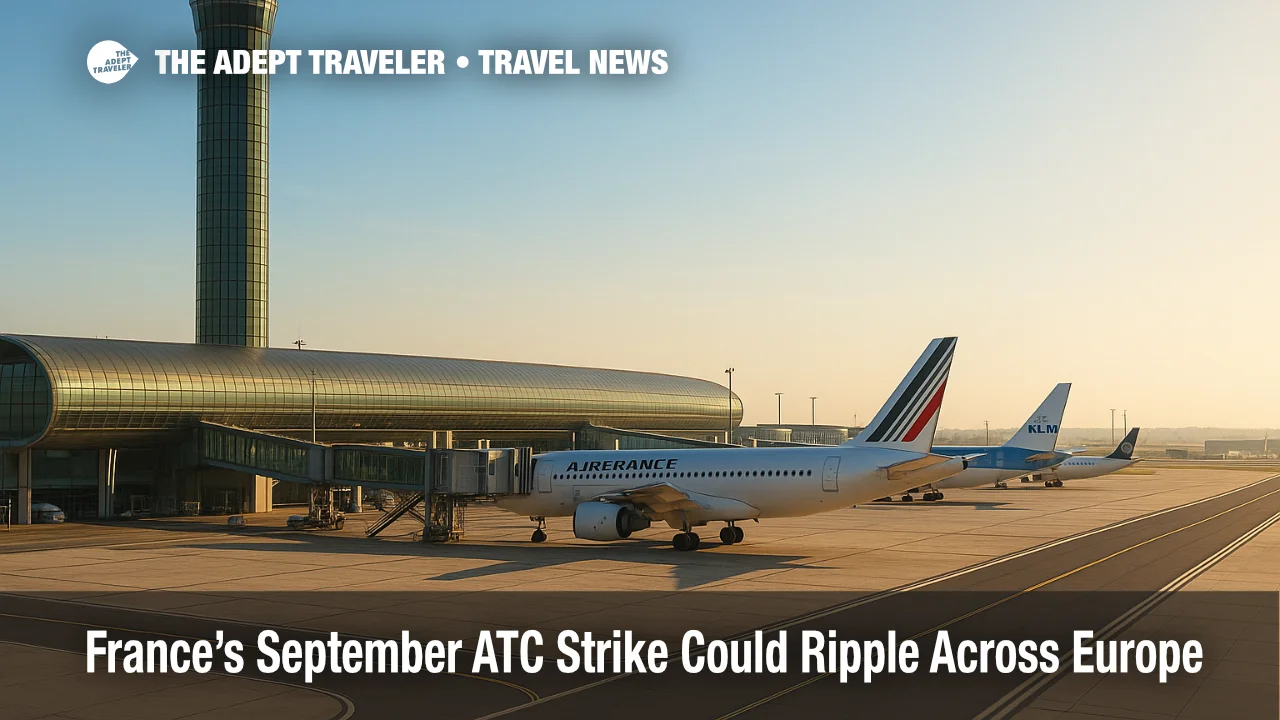France's September ATC strike could ripple across Europe

France's largest air traffic control union, SNCTA, has filed a 24-hour strike notice that would run from the morning of September 18, 2025 through the end of the night shift on September 19. The union cites stalled talks with the Civil Aviation Authority, DGAC, over inflation adjustments and management reforms. Controllers at major hubs including Paris Charles de Gaulle Airport (CDG) and Paris Orly Airport (ORY) are urged to participate, raising the prospect of cancellations in France and delays on overflights across Western Europe.
Key Points
- Why it matters: France controls busy European corridors, so a stoppage can disrupt flights far beyond French airports.
- Travel impact: Expect preemptive schedule cuts at CDG and ORY, plus delays on routes crossing French airspace.
- What's next: DGAC typically publishes flight-reduction directives 24 to 48 hours ahead of a strike.
- SNCTA says dialogue with DGAC has failed, and it wants inflation catch-up and management changes.
- July's smaller-union walkouts triggered over 1 million passenger impacts, a cautionary baseline.
Snapshot
SNCTA, which holds about 60 percent of representativeness among French controllers, mandated a national strike notice after internal votes on August 26, 2025. The notice covers a 24-hour window, from the start of morning duties on September 18 to the end of the following night shift. In similar actions on July 3 and July 4, DGAC ordered airlines to reduce schedules by 25 to 50 percent at airports such as CDG, ORY, Nice Côte d'Azur Airport (NCE), Lyon-Saint-Exupéry Airport (LYS), and Marseille Provence Airport (MRS), with widespread delays across Europe. Eurocontrol estimated more than one million passengers were affected over those two days. Carriers later reported financial hits tied to the July disruption.
Background
The SNCTA argues that French air traffic control, funded by user charges, should receive automatic inflation compensation under European performance plans, and that DGAC's operational governance has eroded trust. In July, strikes led by smaller unions UNSA-ICNA and USAC-CGT forced DGAC to pre-emptively cut flight programs, including up to 50 percent at some airports, with knock-on delays for overflights between countries like the United Kingdom, Spain, and Italy. Reuters and Eurocontrol data show roughly 1,500 cancellations across July 3 and 4, with about 300,000 passengers unable to fly as booked and over a million affected by delays and disruptions. Airlines including easyJet and Ryanair publicly criticized the impact and called for EU-level reforms.
Latest Developments
SNCTA files national notice covering September 18 strike
On August 26, SNCTA's national committee authorized a 24-hour national strike covering controllers and CDG ramp tower agents from the morning of September 18 through the end of the September 19 night shift. The union frames the action as a last resort after what it calls fruitless dialogue with DGAC on 2024 inflation catch-up and operational management. French media reports reiterate SNCTA's representativeness at about 60 percent of the profession, positioning this action as potentially broader than July's stoppages. DGAC customarily issues airport-specific flight-reduction directives 24 to 48 hours before a strike, as it did for July 3 and July 4, when cuts ranged from 25 to 50 percent depending on the airport. Travelers should expect any September reductions to be published in the two days prior to the strike window.
Analysis
A France-wide controller stoppage typically hits three layers of traffic. First, departures and arrivals at major French airports, notably CDG, ORY, NCE, LYS, and MRS, face pre-emptive schedule cuts and longer ground delays. Second, overflights using French upper airspace encounter reroutes, longer flight times, and crew duty-time squeezes, which can cascade to later rotations. Third, downstream European networks absorb the shock, increasing missed connections and mispositioned aircraft, especially for short-haul carriers that turn planes multiple times per day. The July 3 to 4 strike, led by smaller unions, still produced more than one million passenger impacts and roughly 1,500 cancellations across two days, underscoring France's outsized role in the continental network. With SNCTA leading in September, industry planners will model wider protective cuts than in July, then race to re-accommodate customers within EU 261 obligations. Expect low-cost carriers to consolidate frequencies, legacy airlines to protect long-haul and first-wave bank timings, and widespread advice to travel light, accept proactive rebookings, and pad connection times. If DGAC and SNCTA restart talks quickly, targeted exemptions, staffing flex, or flow-control measures could temper the disruption. Otherwise, network delays will likely spill into the weekend.
Final Thoughts
For now, uncertainty is the headline. Watch for DGAC reduction notices in the 24 to 48 hours before September 18, and monitor airline apps for proactive rebookings. If you must connect in Paris, add buffer time or consider retiming your trip to avoid the strike window. Even if your flight does not touch France, plan for longer routings and potential crew-duty knock-ons. Preparation, flexible itineraries, and prompt communication with your carrier remain the best defenses during a French air traffic control strike.
Sources
- Communiqué du comité national, SNCTA
- Impact of the French ATC strike of 3 & 4 July 2025 on European aviation, Eurocontrol
- Aviation Trends Issue 9, July 2025, Eurocontrol PDF
- More than 1,500 flights cancelled on July 3-4, Reuters
- France asks airlines to reduce flights ahead of July strike, Reuters
- French ATC strike, day two disruptions, Reuters
- French controllers announce September 18 strike, TF1 Info
- France's largest ATC union plans strike in September, Euronews
- French ATC strike notice and timing reported, The Connexion
